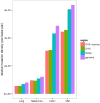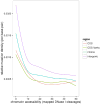Reduced local mutation density in regulatory DNA of cancer genomes is linked to DNA repair
- PMID: 24336318
- PMCID: PMC4116484
- DOI: 10.1038/nbt.2778
Reduced local mutation density in regulatory DNA of cancer genomes is linked to DNA repair
Abstract
Carcinogenesis and neoplastic progression are mediated by the accumulation of somatic mutations. Here we report that the local density of somatic mutations in cancer genomes is highly reduced specifically in accessible regulatory DNA defined by DNase I hypersensitive sites. This reduction is independent of any known factors influencing somatic mutation density and is observed in diverse cancer types, suggesting a general mechanism. By analyzing individual cancer genomes, we show that the reduced local mutation density within regulatory DNA is linked to intact global genome repair machinery, with nearly complete abrogation of the hypomutation phenomenon in individual cancers that possess mutations in components of the nucleotide excision repair system. Together, our results connect chromatin structure, gene regulation and cancer-associated somatic mutation.
Figures




References
-
- Meyerson M, Gabriel S, Getz G. Advances in understanding cancer genomes through second-generation sequencing. Nat Rev Genet. 2010;11:685–96. - PubMed
Publication types
MeSH terms
Substances
Associated data
- Actions
- Actions
Grants and funding
LinkOut - more resources
Full Text Sources
Other Literature Sources
Molecular Biology Databases

